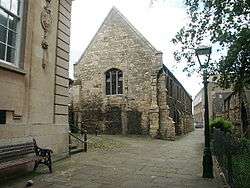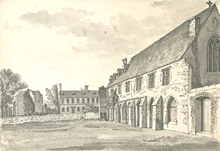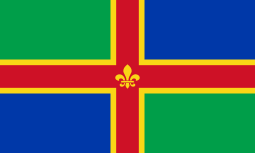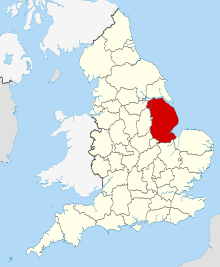Greyfriars, Lincoln
| The Greyfriars, Lincoln | |
|---|---|
 The Greyfriars, Lincoln | |
| Location | The building is adjacent to the Central Library and lies between Free School Lane and Broadgate, Lincoln. |
| Coordinates | 53°13′45″N 0°32′13″W / 53.2293°N 0.5370°WCoordinates: 53°13′45″N 0°32′13″W / 53.2293°N 0.5370°W |
| OS grid reference | SK9775971248 |
| Founded | c1230 |
| Built | 13th century, with mid-19th century additions. |
| Restored | 1906 |
| Architect | William Watkins |
| Architectural style(s) | Early English architecture |
Listed Building – Grade I | |
| Designated | 8 October 1953 |
| Reference no. | 485917 |
 Location in Lincolnshire | |
The Greyfriars, Lincoln was a Franciscan friary in Lincolnshire, England. The surviving building is the remains of the infirmary of the friary, built of dressed stone and brick and dating from c.1230, with mid 19th century additions.[1]
History
Franciscan Friary
Building of the Friary was started in 1237 on land donated to the Franciscan order and was completed by the 1280s. The community was expelled in 1538 as part of the Dissolution of the Monasteries.
Grammar School and Mechanic's Institute
.jpg)
The building was let to William Monson, whose son Richard opened a school there in 1568. From 1574 the school became the Corporation Grammar School run by Lincoln City Council on the upper floor until 1900.[2] The undercroft was successively used as a House of Correction from 1612, a school for the teaching of spinning and knitting from 1620, a Mechanics' Institute from 1833 to 1862 and as part of the Grammar School from 1862.[2] George Boole participated in the Mechanics Institute.[3][4]
City and County Museum

In 1900 the building was closed and restored under the supervision of Lincoln architect William Watkins, after which it was re-opened as the City and County Museum in 1907. The Museum was administered by the City of Lincoln and the first Curator was Arthur Smith. In 1974 control of the Museum passed to Lincolnshire County Council. In September 1993 the museum's use of Greyfriars changed with the building becoming a venue for annually changing exhibitions while its main collections underwent a programme of conservation and research in expectation of a new home being built. In 2005, The Collection opened on a new site on Danesgate, adjacent to the Usher Gallery, with the two being jointly managed as a cultural centre for art and archaeology.[5]
After closure the building was used for a period by the Central Library, but from 2008 has been left vacant, apart from occasional use for contemporary art exhibitions and installations. In 2016 the city council considered selling the building.[6]
Literature
- Antram N (revised), Pevsner N & Harris J, (1989), The Buildings of England: Lincolnshire, Yale University Press. pp 508–9.
- Little A G (1906), Grey Friars of Lincoln in Victoria County History of the County of Lincoln, Vol II (ed. W. Page) pp. 222–4.
- Leach A.F. (1906), Schools-Lincoln Grammar School in Victoria County History of the County of Lincoln, Vol II (ed. W. Page) 421-443
- Martin A R (1935), "The Greyfriars of Lincoln", Archaeological Journal Vol 92, pg 42-63.
- Moore C. N. (1972), City and County Museum, Lincoln. 24pp
- Stocker D.A. (1984), The remains of the Franciscan friary in Lincoln, York Archaeological Papers, York Archaeological Trust, 135-137.
References
- ↑ "Greyfriars' Museum, Lincoln". British Listed Buildings. Retrieved 11 February 2014.
- 1 2 "The Greyfriars". Lincoln City Council. Retrieved 12 February 2014.
- ↑ Francis Hill (1974), Victorian Lincoln; p.149
- ↑ Society for the History of Astronomy, Lincolnshire.
- ↑ History of the museum on The Collection website
- ↑ "Former museum to be sold". City of Lincoln Council. Lincoln City Council. Retrieved 8 January 2017.
External links

- British Listed Buildings

